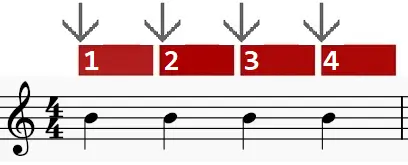The measure’s first and strongest beat serves as the starting point for melodies, harmonic progressions, and rhythmic patterns. However, if you’re new to music, you might find it difficult to identify and feel the downbeat in loops, samples, or recorded parts.
In this article, I’ll explain what the downbeat is and how you can use it in your own music.
What exactly is the downbeat in music?
In music, the initial beat of a measure is known as the downbeat and is typically counted as the first number.
This beat holds significant importance in establishing the melody and harmony of a bar.
It frequently features tonic harmony and a prominent chord tone in the melody, making it the foundation of the musical structure. Moreover, the downbeat functions as the rhythmic cornerstone of the bar, establishing the contrast between strong and weak beats. In addition, the downbeat generates a sense of stability for the listener, driving the music forward in comparison to the remaining beats.
How to Sense a Measure’s Downbeat?
As previously stated, most music listeners associate the downbeat with emphasis.
If you’re having trouble identifying it, try counting numbers in your head while listening to music.
The numbers you count will be determined by the meter or time signature of the music.
The most common are triple meter and quadruple meter, also known as 3/4 or 4/4 time.
Pop songs primarily use 4/4, or common time, for their time signature, but occasionally employ 3/4 or other atypical signatures.
To determine if a piece of music is in 4/4, one can count up to four for each bar, placing emphasis on the initial beat, which is the downbeat. However, if the music carries the distinct waltz rhythm, the time signature may be 3/4, requiring a count from one to three to ascertain the downbeat.
Upbeat and downbeat
You might be wondering what the opposite of downbeat is: upbeat.
It is most commonly used to describe a musical pickup. This is a short figure that comes before the main melody, which starts on the downbeat.
If you need a more in-depth explanation, check out our previous post on pickups in music.
If you only need the basics, the upbeat is typically considered a natural complement to the downbeat because it occurs on a weak beat of the previous measure.
You can see how musical jargon evolved!
Backbeat
Similarly, the term backbeat refers to this method of categorizing measure parts.
It’s a term used to describe drum and percussion patterns in which the snare or claps fall on beats 2 and 4 of the bar.
The backbeat provides the pattern’s point of orientation by providing contrasting emphasis.
How to Employ the Downbeat in Music
If you compose music in regular measures, you’re probably already familiar with the downbeat.
Nonetheless, there are certain styles and artists for whom the downbeat is especially important.
James Brown’s classic style of funk music has a distinct downbeat feel.
This distinct sound can be found in both classic and modern funk. Despite the fact that each player is playing a different interlocking line, they all come together to emphasize the downbeat.
Rhythmic emphasis
The downbeat is an important concept to understand in musical rhythm theory.
Fortunately, once you focus on bars and beats, you can easily feel it.
Now that you understand the fundamentals, return to your DAW and begin creating more beats and grooves.


